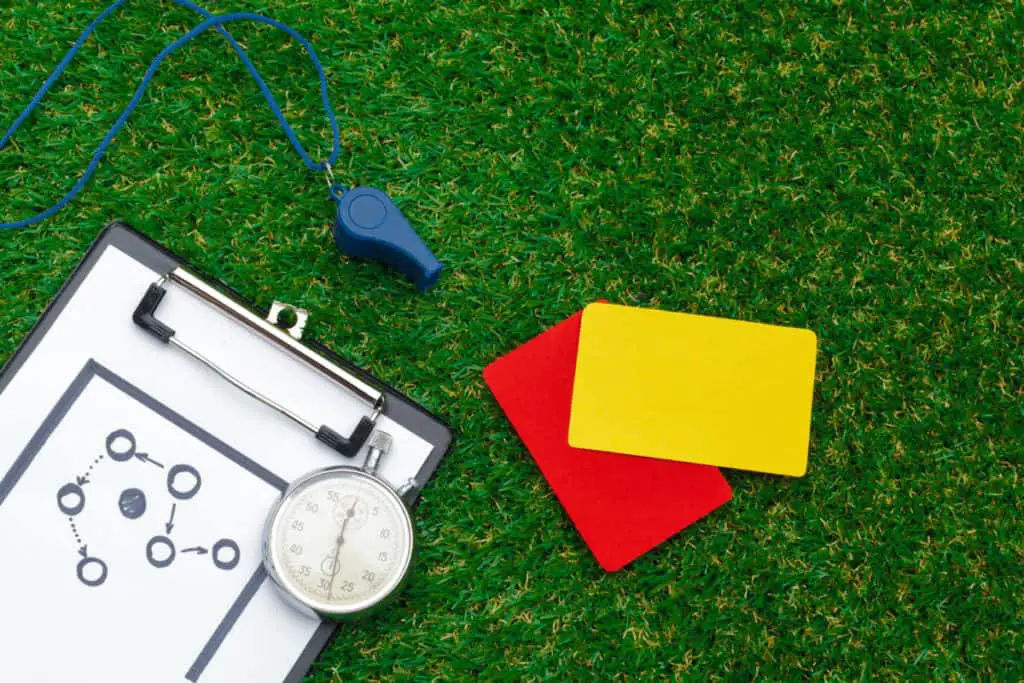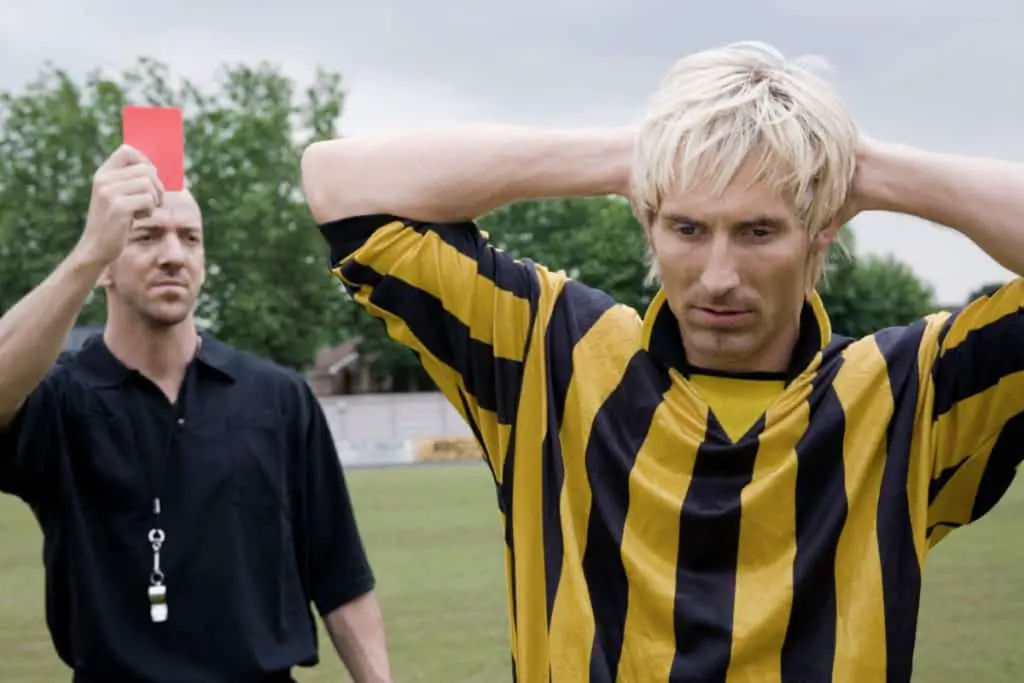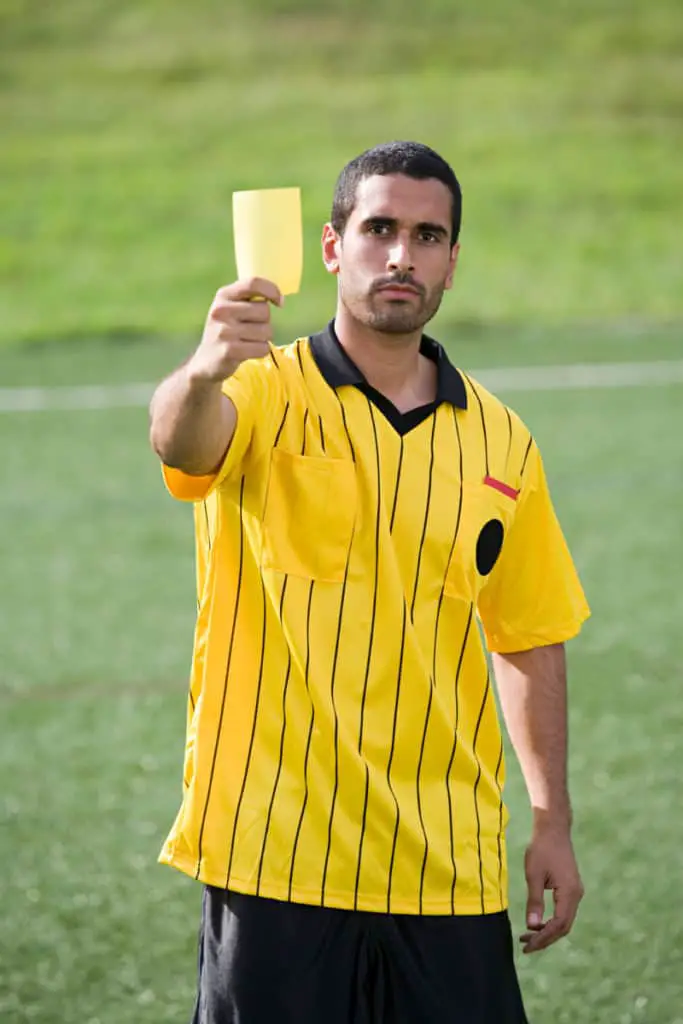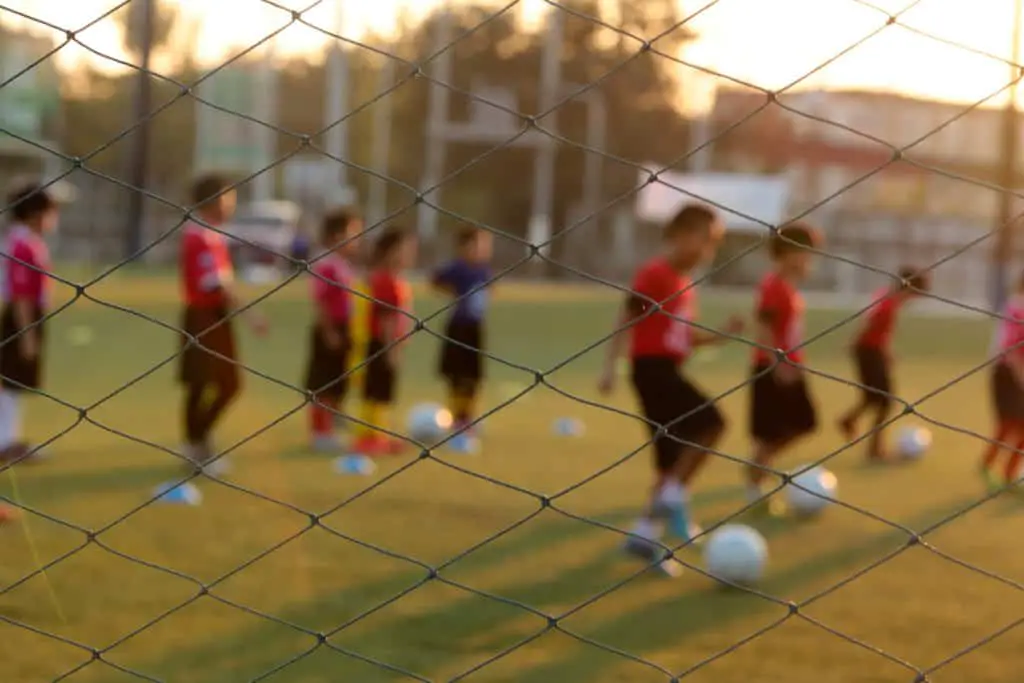Soccer is a game full of passion. Players, coaches and fans can get excited and sometimes go overboard with their response to calls or non calls by the official.
You will also frequently see players go at each other and sometimes unsportsmanlike play is involved. Some people find this part of soccer exciting.
We love the passion around a sport and when that passion rises to certain levels, there are conflicts on the field which sometimes can lead to a yellow card or a red card.

What is a Yellow Card in Soccer
A yellow card is a warning that a player receives for misconduct. A second yellow card results in a player or coach being ejected from the match. There are different penalties that cause a yellow card and it is a universal language that a serious penalty has occurred. While not to the level of a red card, the yellow card is serious and the player or coach now must be careful not to get a second yellow card. There are 6 situations that lead to a yellow card in soccer.
Below we will provide a complete overview of the Yellow Card. The topics includes:
- Why a Yellow Card is Used
- What 6 Penalties Result in a Yellow Card
- Our Thoughts on Yellow Cards
- Youth Level and Yellow Cards
- Examples of Yellow Cards via Video (16)
- Related Questions
Why A Yellow Card Is Used
The yellow and red card system has not been around forever. The origin of the yellow and red card system came about in 1970. Ken Aston, the director of the officiating for the 1966 World Cup, notices that players, coaches and fans did not always know the various levels of the penalty being called.
This was a result of different languages being spoken the language barrier between officials and the players and coaches. As a result in 1970, the officials started using the yellow and red card system.
Quick Reference Guide for Yellow and Red Cards in Soccer
| Card Type | Infraction/Misconduct |
| Yellow | Unsporting Behavior |
| Yellow | Dissent by Action or Word |
| Yellow | Continuous Infringement of Laws |
| Yellow | Delaying Play Restarting |
| Yellow | Not Standing the Required Distance |
| Yellow | Entering or Re-entering the Field |
| Red | Serious Foul Play |
| Red | Spitting and Abusive Language |
| Red | Violence |
| Red | Deliberately Fouling |
| Red | REceiving Two Yellow Cards |

Description: What 6 Penalties Result in a Yellow Card?
Unsporting Behavior
This is a rather subjective call. Some examples include over celebrating a goal or attempting to deceive a referee by “flopping” and faking a penalty.
Dissent by Action or Word
This pretty much doesn’t allow a player to excessively argue with a referee. A yellow card would result in excessive arguing whether in length or noise. The key here is to make sure a player doesn’t “show up” a referee. The referee is ultimately in charge of the field and players need to respect the calls and not go overboard.
Continuous Infringement of Laws
Sounds rather serious doesn’t it? It is assumed that certain rules will be broken by the players in the soccer match. However, persistent breaking of the rules could result in a yellow card.
Delaying Play Restarting
If a player takes too long to execute a free kick or even purposely taking a free kick from the wrong location, so that the kick has to be re-kicked could result in a yellow card.
Not Standing the Required Distance
When a free kick is being attempted, the opposing team must be at least 10 yards back from the spot of the kick. You will often see referees mark this distance off and even use some spray and marks the line. If a player does not honor this distance, the referee can give a yellow card.
Entering or Re-Entering the Field
Players are only allowed to enter or re-enter the field with express permission from the referee. This rule is rather simple to follow. Failure to do so can result in a yellow card.

Our Thoughts on Yellow Cards
The game of soccer is filled with excitement and passion. Players are giving it their all and can sometimes get caught up in the emotion of a game, resulting in making some poor decisions that result in a yellow or red card.
We understand the occasional yellow card, but we promote to our players the importance of staying level headed and being there for their team. Two yellow cards or one red card, does not reflect well on the player or the team and the goal is to be a classy team that wins and losses with respect for the game.
Too often, coaches and fans can also get caught up in arguing with officials or making negative comments to those involved in the game.
We promote a positive approach to the game and playing it the right way. Keeping the game in perspective is important and something we promote with our players and parents.
We want all to develop their skills and learn the life lessons around the great game of soccer. When adults model this behavior we can make progress and ensure the game is treated with respect. Some tips to help you conduct yourself.
Tips to avoid yellow cards:
- Respect the game, know that it is a privilege to be able to play the game. Sports are a great opportunity to compete and challenge yourself. Do not lose sight of that.
- Respect your opponent, even though you want to win, at the end of the day, they are out there playing hard. Never try to intentionally hurt anyone, but do play hard and give it your all.
- Respect the referees, they are ultimately in charge of the game. You can not control what they call, so stay focused on the game and work with your teammates to reach your full potential. Do not let referees become a distraction. Focusing on the referee will take you away from what you need to focus on.
- Strive to play the game the right way by playing with a a high level of sportsmanship. Help people up, and be a good word on. You can still compete, but play with class.

Youth Level and Yellow Cards
A team, with the right coaching and leadership, should be able to get through an entire season without a yellow or red card. The coach is a role model and should model positive interactions with referees, the other coach and the opponents.
Modeling this positive behavior will not only help in the game, but will help kids understand and learn about good sportsmanship. It is easy to get caught up in the emotion of the game, but the best coaches remain calm and collect and manage the game and the players at a high level.
Tips for Coaches:
- Adopt a team philosophy built on developing players are players and people. Share this philosophy with parents and players.
- Continually remind players what the expectionats are.
- Continually remind yourself before, during and after the game why you coach. Most coaches understand it is more about winning, but can get trapped in the emotion of a game.
- Keep your emotions in check by remaining focused on the big picture. Soccer is a game that teaches great life lessons. Stay focused on the big picture.
Examples of Yellow Cards – 16 Yellow Cards and 4 Red Cards
Here are some examples of how yellow cards take place. There is a lot to learn from these yellow cards and instruction with our players that can help prevent yellow cards.
The ugly side of any sport is when a game gets out of control. In the video below the game has turned ugly and players are not respecting the game at the proper level.
Check out the video below:
Related Questions…
How many yellow cards take place in an average game?
Based on research, the number of yellow cards for the typical game will range from 1 to 3 yellow cards with the average somewhere in between these two numbers. In the world cup, where penalties are severe – two yellow cards can lead to a one game suspension, there are less overall yellow cards. However, some key players have missed key games as a result of this rule.
What happens when a red card is issued?
When a red card is issued, it is an automatic ejection from a game. Of course, two yellow cards also results in an ejection. The goal of the yellow card is to warn the player of the infraction and hopefully the player is able to adjust their behavior and prevent being ejected from the game.
Do players have additional consequences if ejected from a game?
At numerous levels there are accumulation penalties that can result when so many overall yellow cards are issued or if a red card occurs. At most high school level games, an ejection from a contest will result in the player being forced to miss up to two more games. The overall goal is to reduce the amount of yellow and red cards. Many times coaches are the biggest offenders of arguing with the referees and the referee can maintain the power of the coach with the threat of the yellow or red cards.
Take Action…
Soccer is truly a wonderful game, we can learn many life lessons and test our physical and mental strength in key situations. Embrace the challenge of competing and maintain your composure.
Soccer is a lifelong game that we can all play into adulthood, coach youth players or support a family member or kid in need on their journey in the game of soccer.
Check out some of our other soccer articles, here.
Here at sportswarrior365, we love many sports and stay active playing, coaching and supporting our kids in their journey with spots. There are many life lessons, make sure you check out some of other posts and join us on the journey together!
